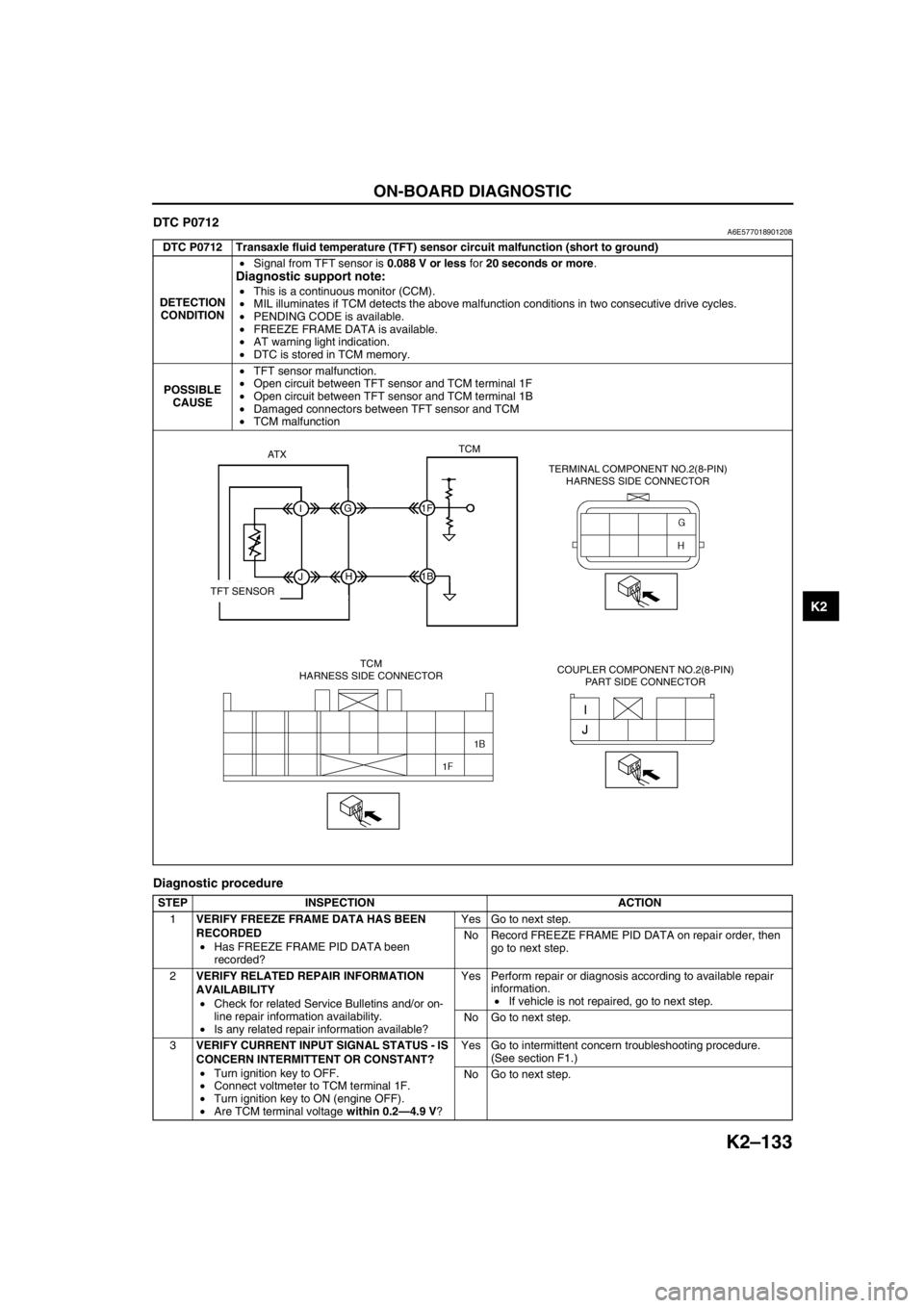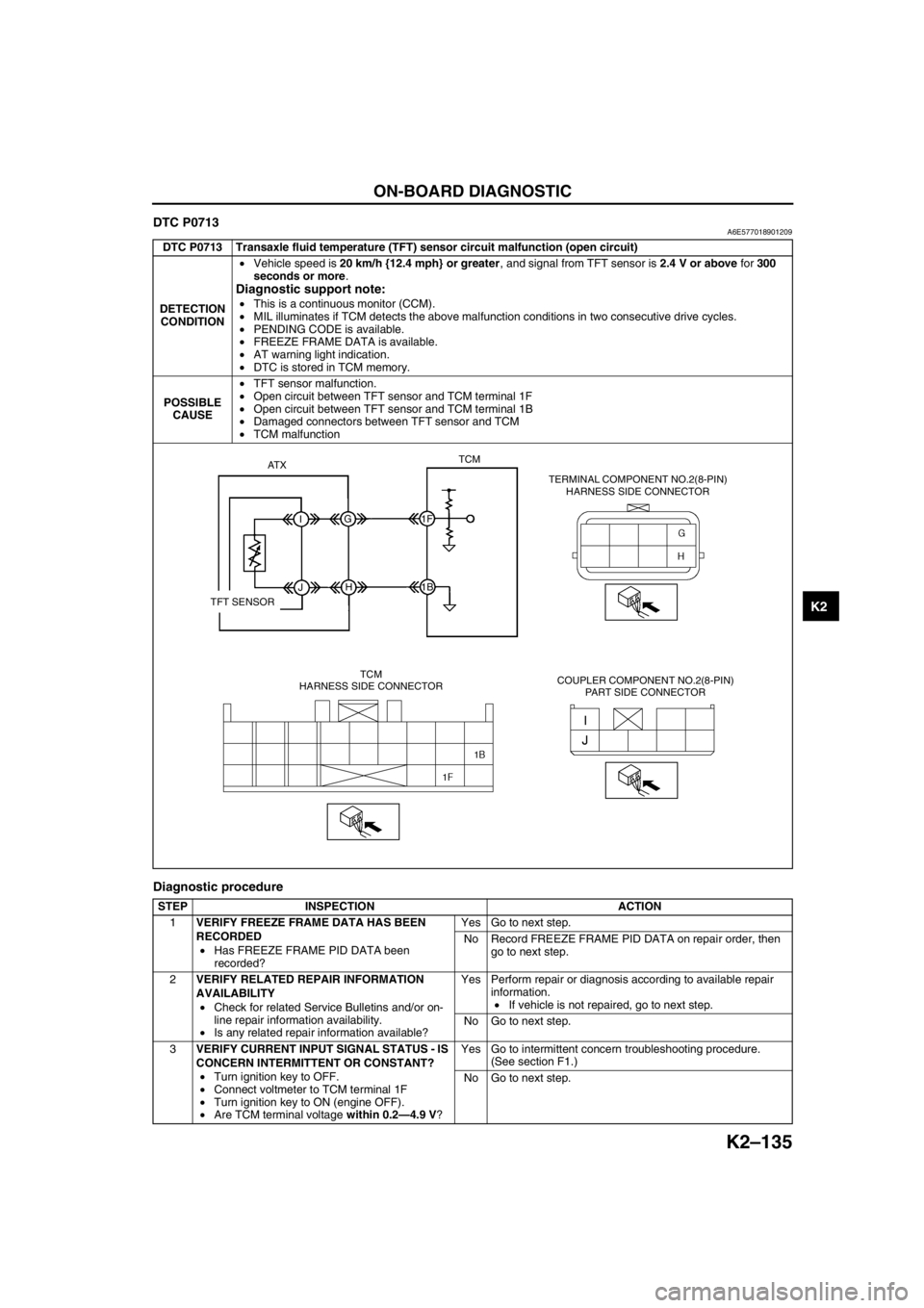engine MAZDA 6 2002 Workshop Manual Suplement
[x] Cancel search | Manufacturer: MAZDA, Model Year: 2002, Model line: 6, Model: MAZDA 6 2002Pages: 909, PDF Size: 17.16 MB
Page 539 of 909

K2–124
ON-BOARD DIAGNOSTIC
AFTER REPAIR PROCEDUREA6E577018901203
Caution
•After repairing a malfunction, perform this procedure to verify that the malfunction has been
corrected.
•When this procedure is carried out, be sure to drive the vehicle at lawful speed and pay attention
to the other vehicles.
1. Connect the SST (WDS or equivalent) to the DLC-2.
2. Turn the ignition key to ON (engine OFF).
3. Select the clear code function and clear the DTC.
4. Perform the following trouble code inspections to ensure that the DTC has been resolved:
•For P0705
i. Start the engine.
ii. Warm up the engine to normal operating temperature.
iii. Depress the brake pedal, and shift the selector lever between P to D for 5 seconds or more.
iv. Go to Step 5.
•For P0706
i. Start the engine.
ii. Warm up the engine to normal operating temperature.
iii. Depress the brake pedal, and shift the selector lever between P to D for 100 seconds or more.
iv. Go to Step 5.
•For P0711
i. Decrease ATF temperature to 20 °C {68 °F} or below.
ii. Start the engine.
iii. Drive the vehicle in D range for 10 minutes or more.
iv. Go to Step 5
•For P0712
i. Start the engine.
ii. Warm up the engine to normal operating temperature.
iii. Drive the vehicle in D range for 20 seconds or more.
iv. Go to Step 5.
•For P0713
i. Start the engine.
ii. Warm up the engine to normal operating temperature.
iii. Drive the vehicle in D range at 20 km/h {12mph} or above for 300 seconds or more.
iv. Go to Step 5.
•For P0715; P0791
i. Start the engine.
ii. Drive the vehicle under the following conditions for 2 seconds or more.
—Vehicle speed (VSS PID): 40 km/h {25 mph} or above
—Engine speed (RPM PID): 1,500 rpm or above.
—Selector lever position: D range
iii. Repeat Step ii again.
iv. Turn the IG switch to OFF.
v. Start the engine.
vi. Drive vehicle under the following conditions for 2 second or more.
—Vehicle speed (VSS PID): 40 km/h {25 mph} or above
—Engine speed (RPM PID): 1,500 rpm or above.
—Selector lever position: D range
vii. Go to Step 5.
•For P0720
i. Start the engine.
ii. Warm up the engine and ATX.
iii. Drive vehicle under the following conditions for 2 seconds or more.
—Selector lever position: D range
—Vehicle speed (VSS PID): 40 km/h {25 mph}
—Engine speed (RPM PID): 1,500 rpm or above.
iv. Go to Step 5.
Page 540 of 909

ON-BOARD DIAGNOSTIC
K2–125
K2
•For P0740
i. Start the engine.
ii. Warm up the engine and ATX.
iii. Drive vehicle under the following conditions for 10 seconds or more.
—Vehicle speed (VSS PID): 76 km/h {47 mph}
—Selector lever position: D range
—TCC operating
iv. Go to Step 5.
•For P0743
i. Start the engine.
ii. Warm up the engine and ATX.
iii. Drive the vehicle in D range and make sure that the gears shift smoothly from 1GR to 5GR and TCC is
operated.
iv. Go to Step 5.
•For P0748, P0751, P0752, P0753, P0756, P0757, P0758, P0761, P0762, P0763, P0768, P0773, P0778,
P0798, P1710, PC073, PC100
i. Start the engine.
ii. Warm up the engine and ATX.
iii. Drive the vehicle in D range and make sure that the gears shift smoothly from 1GR to 5GR.
iv. Go to Step 5.
5. Gradually slow down and stop the vehicle.
6. Make sure that the repaired DTC does not recur.
End Of Sie
Page 543 of 909

K2–128
ON-BOARD DIAGNOSTIC
End Of Sie
3VERIFY CURRENT INPUT SIGNAL STATUS-IS
CONCERN INTERMITTENT OR CONSTANT?
•Connect volt meter to TCM.
•Turn ignition key to ON (engine OFF).
•Inspect TCM terminal voltages.
(See K2–90 TCM INSPECTION.)
—TCM terminal 2B
•P position: B+
•Other positions and all ranges: 0V
—TCM terminal 1W
•R position: B+
•Other positions and all ranges: 0V
—TCM terminal 1T
—N position: B+
—Other positions and all ranges: 0V
—TCM terminal 1Z
•D range: B+
•Other ranges and all positions: 0V
•Are two or more of following terminal voltage at
the same time when shifting selector lever from
P position to D range?Yes Go to next step.
No Go to intermittent concern troubleshooting procedure.
(See section F1.)
4INSPECT TR SWITCH CONNECTOR
•Turn ignition key OFF.
•Disconnect TR switch connector.
•Inspect bent terminals of pins using mirror.
•Are TR switch terminals okay?Yes Go to next step.
No Repair terminals or replace TR switch, then go to Step 8.
(See K2–81 TRANSAXLE RANGE (TR) SWITCH
REMOVAL/INSTALLATION.)
5INSPECT TR SWITCH CIRCUIT MALFUNCTION
•Connect voltmeter to TCM.
•Turn ignition key to ON (engine OFF).
•Does TCM terminal voltage change from B+ to
0V when TR switch connector is disconnected?Yes Go to next step.
No Go to Step 7.
6INSPECT TR SWITCH CONTINUITY
•Turn ignition key to OFF.
•Disconnect TR switch connector.
•Inspect TR switch for continuity in positions/
ranges failed in Step 4.
•Is there continuity between TR switch terminals
(part side)?
(See K2–80 TRANSAXLE RANGE (TR) SWITCH
INSPECTION.)Yes Go to Step 8.
No Replace TR switch, then go to Step 8.
(See K2–81 TRANSAXLE RANGE (TR) SWITCH
REMOVAL/INSTALLATION.)
7INSPECT TR SWITCH CIRCUIT FOR SHORT TO
POWER
•Turn ignition key to ON (engine OFF).
•Measure voltage at TR switch terminal A, E, D,
G, I, and F (harness-side).
•Is there 0 V at TR switch harness side
connector?Yes Go to next step.
No Repair or replace wiring, then go to next step.
8VERIFY TROUBLESHOOTING OF DTC P0705
COMPLETED
•Make sure to reconnect all disconnected
connectors.
•Clear DTC from memory using WDS or
equivalent.
•Turn ignition key to on (engine off).
•Drive vehicle in each range (P, R, N, and D) for
5 seconds or more.
•Is same DTC present?Yes Replace TCM, then go to next step.
(See K2–96 TCM REMOVAL/INSTALLATION.)
No Go to next step.
9VERIFY AFTER REPAIR PROCEDURE
•Perform “After Repair Procedure”.
(See K2–124 AFTER REPAIR PROCEDURE.)
•Is there any DTC present?Yes Go to applicable DTC inspection.
No Troubleshooting completed. STEP INSPECTION ACTION
Page 545 of 909

K2–130
ON-BOARD DIAGNOSTIC
2VERIFY RELATED REPAIR INFORMATION
AVAILABILITY
•Check for related Service Bulletins and/or on-
line repair information availability.
•Is any related repair information available?Yes Perform repair or diagnosis according to available repair
information.
•If vehicle is not repaired, go to next step.
No Go to next step.
3INSPECT TCM CONNECTOR FOR POOR
CONNECTION
•Turn ignition key to OFF.
•Check for poor connection (damaged pulled-
out terminals, corrosion, etc.).
•Are terminals okay?Yes Go to next step.
No Repair terminals, then go to Step 12.
4INSPECT TR SWITCH CIRCUIT
•Connect voltmeter to TCM.
•Inspect TCM terminal voltage.
—TCM terminal 2B
•P position: B+
•Other positions and all ranges: 0V
—TCM terminal 1W
•R position: B+
•Other position and all ranges: 0V
—TCM terminal 1T
•N position: B+
•Other position and all range: 0V
—TCM terminal 1Z
•D range: B+
•Other ranges and all positions: 0V
•Are any of following terminal voltage turned on
for even a moment while shifting selector lever
slowly from P position to D range?Yes Adjust TR switch, then go to Step 12.
(See K2–83 TRANSAXLE RANGE (TR) SWITCH
ADJUSTMENT.)
No Go to next step.
5INSPECT TR SWITCH CONNECTOR FOR POOR
CONNECTION
•Turn ignition key to OFF.
•Check for poor connection (damaged pulled-
out terminals, corrosion, etc.).
•Are terminals okay?Yes Go to next step.
No Repair terminals, then go to Step 12.
6INSPECT TR SWITCH CIRCUIT
•Disconnect TR switch connector.
•Connect voltmeter to TCM.
•Turn ignition key to ON (engine OFF).
•Connect harness side connector power line
and signal line using jumper wire
—P position: C and A
—R position: C and E
—N position: C and D
—D range: C and G
•Inspect if terminal voltage changes.
—0V to B+
•Does terminal voltage change?Yes Go to next step.
No Go to Step 9.
7INSPECT TR SWITCH FOR OPEN CIRCUIT
•Turn ignition key to OFF.
•Inspect continuity between TR switch terminals
(part side).
—P position: C and A
—R position: C and E
—N position: C and D
—D range: C and G
•Is there continuity between TR switch terminals
(part side)?
(See K2–80 TRANSAXLE RANGE (TR) SWITCH
INSPECTION.)Yes Go to Step 12.
No Replace TR switch, then go to Step 12.
(See K2–81 TRANSAXLE RANGE (TR) SWITCH
REMOVAL/INSTALLATION.)
8INSPECT TR SWITCH POWER CIRCUIT FOR
OPEN CIRCUIT
•Check voltage at TR switch terminal C
(harness-side).
•Is there B+ at TR switch terminal C (harness-
side)?Yes Go to next step.
No Inspect main fuse.
•If okay, repair or replace wiring, then go to Step 12. STEP INSPECTION ACTION
Page 547 of 909

K2–132
ON-BOARD DIAGNOSTIC
DTC P0711A6E577018901207
Diagnostic procedure
End Of Sie
DTC P0711 Transaxle fluid temperature (TFT) sensor malfunction (stuck)
DETECTION
CONDITION•TFT sensor signal stays outside normal temperature range for 10 minute or more.
Diagnostic support note:
•This is a continuous monitor (CCM).
•MIL illuminates if TCM detects the above malfunction conditions in two consecutive drive cycles.
•PENDING CODE is available.
•FREEZE FRAME DATA is available.
•AT warning light does not indication.
•DTC is stored in TCM memory.
POSSIBLE
CAUSE•TFT sensor malfunction.
•Connector corrosion.
•TCM malfunction.
STEP INSPECTION ACTION
1VERIFY FREEZE FRAME DATA HAS BEEN
RECORDED
•Has FREEZE FRAME PID DATA been
recorded?Yes Go to next step.
No Record FREEZE FRAME PID DATA on repair order, then
go to next step.
2VERIFY RELATED REPAIR INFORMATION
AVAILABILITY
•Check for related Service Bulletins and/or on-
line repair information availability.
•Is any related repair information available?Yes Perform repair or diagnosis according to available repair
information.
•If vehicle is not repaired, go to next step.
No Go to next step.
3INSPECT TFT SENSOR VOLTAGE
•Connect voltmeter to TCM terminal 1F.
•Turn ignition key to ON (engine OFF).
•Is TCM terminal voltage 1.55 V?Yes Go to next step.
No Go to Step 6.
4VERIFY CURRENT INPUT SIGNAL STATUS - IS
CONCERN INTERMITTENT OR CONSTANT?
•Start engine.
•Drive vehicle at 60 km/h {37 mph} or above
for 10 minutes or more.
—ATF 20 °C {68 °F}: 1.55 V
—ATF 60 °C {140 °F}: 0.7 V
•Does TCM terminal voltage change?Yes Go to Step 6.
No Go to next step.
5INSPECT TERMINAL CONDITION
•Turn ignition key to OFF.
•Disconnect terminal component No.2 (8-pin).
•Inspect terminals for corrosion.
•Are terminals okay?Yes Replace TFT sensor, then go to next step.
No Repair or replace terminals, then go to next step.
6VERIFY TROUBLESHOOTING OF DTC P0711
COMPLETED
•Make sure to reconnect all disconnected
connectors.
•Clear DTC from memory using WDS or
equivalent.
•Decrease ATF temperature to 20 °C {68 °F} or
below.
•Drive vehicle at 60 km/h {37 mph} or above
for 10 minutes or more.
•Is same DTC present?Yes Replace TCM, then go to next step.
(See K2–96 TCM REMOVAL/INSTALLATION.)
No Go to next step.
7VERIFY AFTER REPAIR PROCEDURE
•Perform “After Repair Procedure”.
(See K2–124 AFTER REPAIR PROCEDURE.)
•Is there any DTC present?Yes Go to applicable DTC inspection.
No Troubleshooting completed.
Page 548 of 909

ON-BOARD DIAGNOSTIC
K2–133
K2
DTC P0712A6E577018901208
Diagnostic procedure
DTC P0712 Transaxle fluid temperature (TFT) sensor circuit malfunction (short to ground)
DETECTION
CONDITION•Signal from TFT sensor is 0.088 V or less for 20 seconds or more.
Diagnostic support note:
•This is a continuous monitor (CCM).
•MIL illuminates if TCM detects the above malfunction conditions in two consecutive drive cycles.
•PENDING CODE is available.
•FREEZE FRAME DATA is available.
•AT warning light indication.
•DTC is stored in TCM memory.
POSSIBLE
CAUSE•TFT sensor malfunction.
•Open circuit between TFT sensor and TCM terminal 1F
•Open circuit between TFT sensor and TCM terminal 1B
•Damaged connectors between TFT sensor and TCM
•TCM malfunction
STEP INSPECTION ACTION
1VERIFY FREEZE FRAME DATA HAS BEEN
RECORDED
•Has FREEZE FRAME PID DATA been
recorded?Yes Go to next step.
No Record FREEZE FRAME PID DATA on repair order, then
go to next step.
2VERIFY RELATED REPAIR INFORMATION
AVAILABILITY
•Check for related Service Bulletins and/or on-
line repair information availability.
•Is any related repair information available?Yes Perform repair or diagnosis according to available repair
information.
•If vehicle is not repaired, go to next step.
No Go to next step.
3VERIFY CURRENT INPUT SIGNAL STATUS - IS
CONCERN INTERMITTENT OR CONSTANT?
•Turn ignition key to OFF.
•Connect voltmeter to TCM terminal 1F.
•Turn ignition key to ON (engine OFF).
•Are TCM terminal voltage within 0.2—4.9 V?Yes Go to intermittent concern troubleshooting procedure.
(See section F1.)
No Go to next step.
AT XTCM
IG1F
1B
JH
TFT SENSOR
TCM
HARNESS SIDE CONNECTORTERMINAL COMPONENT NO.2(8-PIN)
HARNESS SIDE CONNECTOR
COUPLER COMPONENT NO.2(8-PIN)
PART SIDE CONNECTOR
Page 549 of 909

K2–134
ON-BOARD DIAGNOSTIC
End Of Sie
4INSPECT TERMINAL CONDITION
•Turn ignition key to OFF.
•Disconnect terminal component No.2.
•Inspect bent terminals.
•Is there any malfunction?Yes Repair or replace terminals, then go to Step 9.
•If terminals cannot be repaired, replace harness, then
go to Step 9.
No Go to next step.
5INSPECT TFT SENSOR CIRCUIT
•Turn ignition key to ON (engine OFF).
•Verify if TCM terminal voltage changes to 4.9 V
or above when terminal component No.2
disconnected.
•Does TCM terminal voltage change?Yes Go to next step.
No Go to Step 8.
6INSPECT COUPLER COMPONENT (8-PIN)
TERMINALS CONDITION
•Turn ignition key to OFF.
•Disconnect coupler component (8-pin)
connector.
•Inspect bent coupler component (8-pin)
terminals.
•Is there any malfunction?Yes Repair or replace connector and/or terminal.
No Go to next step.
7INSPECT COUPLER COMPONENT (8-PIN)
CIRCUIT FOR SHORT TO GROUND
•Check continuity between coupler component
(8-pin) terminals (part-side) and body ground.
—I and body ground
—J and body ground
•Is there any continuity?Yes Replace TFT sensor, then go to Step 9.
No Repair or replace coupler component, then go to Step 9.
8INSPECT TERMINAL COMPONENT NO.2 (8-
PIN) CIRCUIT FOR SHORT TO GROUND
•Turn ignition key to OFF.
•Check continuity between terminal component
No.2 terminal G (harness-side) and body
ground.
•Is there any continuity?Yes Repair or replace harness, then go to next step.
No Go to next step.
9VERIFY TROUBLESHOOTING OF DTC P0712
COMPLETED
•Make sure to reconnect all disconnected
connectors.
•Clear DTC from memory using WDS or
equivalent.
•Drive vehicle under following condition for 150
seconds or more.
—Vehicle speed (VSS PID): 20 km/h {12
mph}
•Is same DTC present?Yes Replace TCM, then go to next step.
(See K2–96 TCM REMOVAL/INSTALLATION.)
No Go to next step.
10VERIFY AFTER REPAIR PROCEDURE
•Perform “After Repair Procedure”.
(See K2–124 AFTER REPAIR PROCEDURE.)
•Is there any DTC present?Yes Go to applicable DTC inspection.
No Troubleshooting completed. STEP INSPECTION ACTION
Page 550 of 909

ON-BOARD DIAGNOSTIC
K2–135
K2
DTC P0713A6E577018901209
Diagnostic procedure
DTC P0713 Transaxle fluid temperature (TFT) sensor circuit malfunction (open circuit)
DETECTION
CONDITION•Vehicle speed is 20 km/h {12.4 mph} or greater, and signal from TFT sensor is 2.4 V or above for 300
seconds or more.
Diagnostic support note:
•This is a continuous monitor (CCM).
•MIL illuminates if TCM detects the above malfunction conditions in two consecutive drive cycles.
•PENDING CODE is available.
•FREEZE FRAME DATA is available.
•AT warning light indication.
•DTC is stored in TCM memory.
POSSIBLE
CAUSE•TFT sensor malfunction.
•Open circuit between TFT sensor and TCM terminal 1F
•Open circuit between TFT sensor and TCM terminal 1B
•Damaged connectors between TFT sensor and TCM
•TCM malfunction
STEP INSPECTION ACTION
1VERIFY FREEZE FRAME DATA HAS BEEN
RECORDED
•Has FREEZE FRAME PID DATA been
recorded?Yes Go to next step.
No Record FREEZE FRAME PID DATA on repair order, then
go to next step.
2VERIFY RELATED REPAIR INFORMATION
AVAILABILITY
•Check for related Service Bulletins and/or on-
line repair information availability.
•Is any related repair information available?Yes Perform repair or diagnosis according to available repair
information.
•If vehicle is not repaired, go to next step.
No Go to next step.
3VERIFY CURRENT INPUT SIGNAL STATUS - IS
CONCERN INTERMITTENT OR CONSTANT?
•Turn ignition key to OFF.
•Connect voltmeter to TCM terminal 1F
•Turn ignition key to ON (engine OFF).
•Are TCM terminal voltage within 0.2—4.9 V?Yes Go to intermittent concern troubleshooting procedure.
(See section F1.)
No Go to next step.
AT XTCM
IG1F
1B
JH
TFT SENSOR
TCM
HARNESS SIDE CONNECTORTERMINAL COMPONENT NO.2(8-PIN)
HARNESS SIDE CONNECTOR
COUPLER COMPONENT NO.2(8-PIN)
PART SIDE CONNECTOR
Page 551 of 909

K2–136
ON-BOARD DIAGNOSTIC
End Of Sie
4INSPECT TERMINAL COMPONENT NO.2 (8-
PIN) FOR POOR CONNECTION
•Turn ignition key to OFF.
•Inspect terminal component No.2 (8-pin)
connection.
•Disconnect terminal component No.2 (8-pin).
•Check for poor connection (damaged, pulled-
out terminals, corrosion etc.).
•Are connector and terminals okay?Yes Go to next step.
No Repair or replace connector and/or terminal, then go to
Step 11.
5INSPECT TFT SENSOR CIRCUIT
•Connect voltmeter to TCM terminal 1F.
•Turn ignition key to ON (engine OFF).
•Connect between terminal component No.2 (8-
pin) terminal H and G (harness-side) using
jumper wire.
•Verify if TCM terminal voltage changes to 0.2 V
or below.
•Does TCM terminal voltage change?Yes Go to next step.
No Go to Step 8.
6INSPECT COUPLER COMPONENT
CONNECTOR CONNECTION FOR POOR
CONNECTION
•Turn ignition key to OFF.
•Remove control valve body cover.
•Disconnect coupler component connector.
•Check for poor connection (damaged, pulled-
out terminals, corrosion, etc.).
•Are terminals okay?Yes Go to next step.
No Repair or replace connector and/or terminal, then go to
Step 11.
7INSPECT COUPLER COMPONENT CIRCUIT
FOR OPEN CIRCUIT
•Check continuity between coupler component
(8-pin) terminals I and J (part-side).
•Is there continuity?Yes Repair or replace terminal component No.2 (8-pin).
No Replace TFT sensor, then go to Step 11.
(See K2–85 TRANSAXLE FLUID TEMPERATURE (TFT)
SENSOR REMOVAL/INSTALLATION.)
8INSPECT TCM CONNECTOR FOR POOR
CONNECTION
•Turn ignition key to OFF.
•Disconnect TCM connector.
•Check for poor connection (damaged, pulled-
out terminals, corrosion, etc.).
•Are terminals okay?Yes Go to next step.
No Repair terminals, then go to Step 11.
9INSPECT HARNESS FOR OPEN CIRCUIT
•Disconnect terminal component No.2 (8-pin)
•Connect the TCM connector.
•Turn ignition key to ON (engine OFF).
•Inspect voltage at terminal component No.2 (8-
pin) terminal G (harness-side).
•Is voltage 5 V?Yes Go to next step.
No Repair or replace harness, then go to Step 11.
10INSPECT TERMINAL COMPONENT NO.2 (8-
PIN) CIRCUIT FOR OPEN CIRCUIT
•Turn ignition key to OFF.
•Check continuity between terminal component
No.2 (8-pin) terminal H (harness-side) and
body ground.
•Is there continuity?Yes Go to next step.
No Repair or replace harness, then go to next step.
11VERIFY TROUBLESHOOTING OF DTC P0713
COMPLETED
•Make sure to reconnect all disconnected
connectors.
•Clear DTC from memory using WDS or
equivalent.
•Drive vehicle for 150 seconds or more.
•Is same DTC present?Yes Replace TCM, then go to next step.
(See K2–96 TCM REMOVAL/INSTALLATION.)
No Go to next step.
12VERIFY AFTER REPAIR PROCEDURE
•Perform “After Repair Procedure”.
(See K2–124 AFTER REPAIR PROCEDURE.)
•Is there any DTC present?Yes Go to applicable DTC inspection.
No Troubleshooting completed. STEP INSPECTION ACTION
Page 552 of 909

ON-BOARD DIAGNOSTIC
K2–137
K2
DTC P0715A6E577018901210
DTC P0715 Input/turbine speed sensor circuit malfunction
DETECTION
CONDITION•The following condition is detected twice:
—Input/turbine speed sensor signal is 600 rpm or less while engine speed is 1,500 rpm or greater and
vehicle speed is 40 km/h {24.8 mph} or greater in D range.
Diagnostic support note:
•This is a continuous monitor (CCM).
•MIL illuminates if TCM detects the above malfunction conditions in two consecutive drive cycles.
•PENDING CODE is available.
•FREEZE FRAME DATA is available.
•AT warning light indication.
•DTC is stored in TCM memory.
POSSIBLE
CAUSE•Input/turbine speed sensor malfunction.
•Short to ground between input/turbine speed sensor terminal B and TCM terminal 1N
•Short to ground between input/turbine speed sensor terminal A and TCM terminal 2F
•Open circuit between input/turbine speed sensor terminal B and TCM terminal 1N
•Open circuit between input/turbine speed sensor terminal A and TCM terminal 2F
•Damaged connectors between input/turbine speed sensor and TCM.
•TCM malfunction.
AT X
B
E1NTCM
TCM
HARNESS SIDE CONNECTOR
TERMINAL COMPONENT
NO.2(8-PIN)
HARNESS SIDE CONNECTORCOUPLER COMPONENT
(8-PIN)
PART SIDE CONNECTORINPUT/TURBINE
SPEED SENSOR
HARNESS SIDE CONNECTOR 2F B
A
A
F
INPUT/TURBINE
SPEED SENSOR